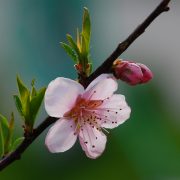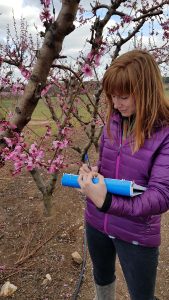
Breaking Bud
by Stone Washington
The cultivation of fruit is a complex process. The timing of bud break is critical for fruit trees—especially peach trees, South Carolina’s number one fruit crop. It must occur at just the right time in order to avoid late frosts which can kill unprotected buds. During development and before blooming and developing into fruit, the buds are capable of surviving vast fluctuations in chilling and warming temperatures.
 The Breaking Bud: Investigating the Environmental Control of Spring Bloom Timing in Peaches Creative Inquiry project’s goal is to determine if different peach varieties have different temperature requirements for development. The peach tree is the perfect fruit tree to investigate because it is one of the best genetically characterized flowering trees. The genome of a peach tree is almost half that of a rice plant, and as a result much simpler to analyze.
The Breaking Bud: Investigating the Environmental Control of Spring Bloom Timing in Peaches Creative Inquiry project’s goal is to determine if different peach varieties have different temperature requirements for development. The peach tree is the perfect fruit tree to investigate because it is one of the best genetically characterized flowering trees. The genome of a peach tree is almost half that of a rice plant, and as a result much simpler to analyze.

Counting blossoms on peach trees.
To investigate the budding and blooming cycle, Dr. Douglas Bielenberg in the Department of Biological Sciences and his Creative Inquiry team are tracking the specific time of bud break in different varieties of peaches. In their initial study, they made observations on bud break on more than 30,000 individual buds from 54 varieties of peaches. The students were surprised to find that the base temperature and thermal times for bud break varied greatly among the varieties.
Temperature and temperature fluctuations are important factors affecting bloom timing in peaches, it is important to maintain proper balance between cooling and warming for crop survival. The buds must develop at the right time between the end of winter and the beginning of spring, avoiding opening prematurely which could end in subsequently dying from a late frost. Second, it is essential to have slow and steady warming by spring weather to allow the bud to mature.
Peach losses from frost can be devastating. Several years ago, growers lost their peach crop due to a late frost in the season. “If you’re a peach grower, you lose your flowers in the spring; that’s your one opportunity to make money all year,” Bielenberg said. “So that’s it. You’re done. Your annual income is gone. So, if we can do anything to help make that occurrence less frequent, then that’s a really big help to growers in that industry.” The team is continuing to work one bud at a time to identify the precise environmental mechanisms governing bud and bloom in different peach varieties in hopes of eventually providing fruit growers with a way to avoid unexpected crop failures.


